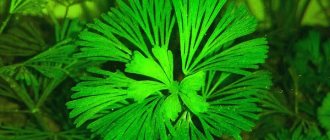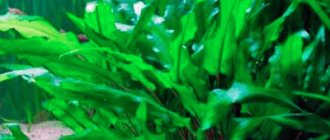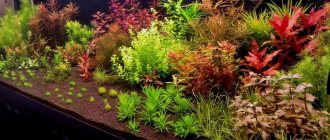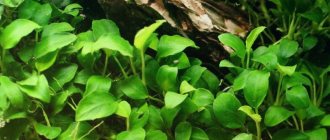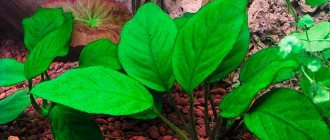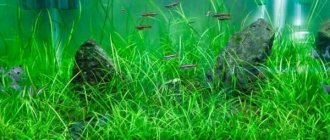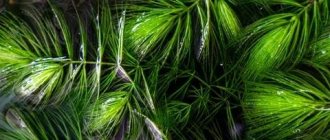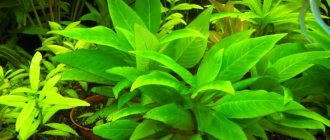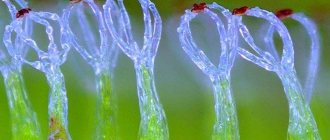Most popular types
Depending on the species, the color of Ludwigia leaves can be different, including with a red tint. Domestication has meant that they can be kept in a variety of environments, not just warm tropical waters. Some aquarists believe that the selected forms of plants differ little from each other, and the foliage gets a different shade due to the conditions of detention. There are also unpretentious species that are suitable for breeding by beginners:
Palustris or swamp - this species loves clean water and good lighting. Given the right conditions, it will grow quickly. If you decide to plant palustris in your aquarium, then the water in it should be 22-26 degrees, with hardness from 2 to 12, acidity from 6 to 7.5 pH.
Creeping or repens is distinguished by oval glossy leaves. Its color is dark green on top, and in the lower part near the stems it becomes reddish-purple. The plant reaches a length of 30-40 cm.
Inclinata Cuban - when transferred from its habitat to the aquarium, this variety changed its appearance: its leaves elongated and began to grow as close to each other as possible.
Super Red (Super Red) - this species differs from others in its unusual leaf color. They are red in color and do not lose the intensity of the shade due to insufficient light exposure. In specialized stores you can find this variety under different names; you can recognize it by its appearance.
The Peruvian or red star is a long-stemmed species suitable for an aquarium larger than 150 liters. Due to its length, the plant is planted only along the back wall, otherwise it will obscure the view. This species changes its color depending on the conditions in the aquarium, the upper part of the leaves is usually green or brown, and the lower part is red.
Tornado is an unusual variety bred in Vietnam. It has twisted leaves growing in whorls of thick stems. The plant will be tidy only with timely supply of fertilizers, a sufficient amount of carbon dioxide and reduced water hardness.
Arcuata or arcuate is a plant with a long stem and narrow leaves arranged in pairs. If you create the right conditions, the foliage will turn brown-red. The plant grows up to 30 cm in length. For normal development, it needs to warm the water to 22-27 degrees, keep its hardness between 1 and 20, and adjust the acidity parameter from 6 to 8 pH.
Ruby - This variety is often considered a subspecies of Super Red, as they are similar in foliage color. Ludwigia ruby is distinguished by a dense brown stem, large leaves 3 cm long and 2 cm wide, and changes in color if not properly cared for.
The floating one loves the most intense light - up to 1.5 W/l. It differs from other species in its elongated stem, reaching a length of up to 1 meter. Rounded leaves are attached to it in pairs, which can only exist on the surface of the water. If you try to “drown” the plant, its foliage will quickly die off.
These are the most beautiful and common Ludwigias in home aquariums. In total, there are more than 75 variants of this plant in the world.
Popular varieties for the aquarium
The plant amazes with its diversity. There are about 75 species of Ludwigia worldwide, including artificially bred varieties. Varieties may differ in bush size and leaf color.
Most often, aquarists purchase the following species:
- Bolotnaya. It has the longest and most branched stem among all its fellows. The leaves are light olive green above and reddish-purple below. Under optimal conditions it can bloom. This variety easily tolerates transplantation, breeding and changes in the parameters of the aquatic environment. The plant has two subspecies - Ludwigia angustifolia and variegata.
- Glandulose. This interesting grass is also called glandular grass. Glandulose has a thick stem that grows upward and does not lie on the surface. The leaf blades are distinguished by their elongated, pointed shape and pinkish-red hue. Underwater the color is less bright. This variety is characterized by slow growth. It is important to create comfortable conditions for glandulose, since it does not tolerate fluctuations in water and sheds its leaves at the slightest change.
The duration of daylight for Ludwigia should be at least 12 hours. - Arc-shaped. This type is also called arcuata. This Ludwigia is ideal for creating a tropical corner. The plant has thin elongated leaves with a bright color that changes from green to brown-red. If you increase the water hardness, then the color of the bush becomes more intense.
- Oval, or ovalis. An aquatic pet from East Asia has a straight stem of a red hue, which is covered with elongated oval leaves. The lower part of the plates is red, and the upper part can vary from dark green to reddish. The leaves on the stem are arranged in the form of a blossoming bud. The original appearance makes ovalis an excellent solution for decorating an aquarium. The plant is characterized by a low growth rate. It needs to be fertilized regularly, as due to a lack of minerals it begins to rot.
- Creeping. Keeping Ludwigia in an aquarium does not cause problems even for beginners, which is why this variety is considered the most popular. It has oval leaves that are green on top and reddish-purple underneath. Grass grows well throughout the year if the necessary conditions are provided for it. A subspecies of creeping ludwigia is ruby. Beautiful leaf blades are characterized by an intense scarlet color. Bright bushes look original against the background of aquarium greenery.
Based on crossing creeping and swamp ludwigs, breeders developed a hybrid variety. It easily adapts to aquarium conditions and is characterized by rapid growth. The hybrid look has good branching, which can be enhanced by regular trimming. The plant is covered with oval leaves with a glossy surface. The upper part of the plates can be olive or bright green, and the lower part can be reddish or pale greenish.
How to keep a plant
A feature of Ludwigia is its uniform development and growth throughout the year. This plant can be planted in an aquarium of any size. In large containers it is planted near the rear or side walls. It is necessary to create optimal tropical conditions:
| Conditions of detention | Recommendations |
| Climate | The optimal water temperature should range from 20 to 28 degrees. |
| Hardness and acidity | These water conditions are not particularly important for ludwigia. The plant tolerates weak acidic and alkaline environments well. With a hardness of more than 8 dH, the color of the foliage becomes more intense. |
| Updating fluid volume | It is recommended to change up to 30% of the total water volume once a week. |
| The soil | You can choose whether to root the plant or leave it floating on the surface. If you plant it in the ground, Ludwigia will develop faster. |
| Lighting | It must be diffuse. Aquariums located near a window or equipped with weak lamps work well. With this lighting, the redness will disappear from the leaves and a rich green tint will appear. They will look more attractive. If you choose fluorescent lamps, their power should be 0.5 W/l. You can add a 40 W incandescent lamp to the aquarium. The duration of light for Ludwigia should be at least 12 hours. |
Proper care allows the plant to develop as quickly as possible. You can determine whether you have truly created optimal conditions by the color of the leaves.
Ludwigia arcuata
Onagraceae family - Onagraceae. Homeland - North America.
A very elegant, unique ornamental plant with long stems on which light green narrow leaves sit in pairs, which, under satisfactory maintenance conditions, acquire a red-brown color. The length of the stems usually reaches 20 - 30 cm. Ludwigia can be grown in a container of any size, but with a low water level. In a large aquarium, plants are placed on the side shelves, planted in separate pots. Despite the originality and relative unpretentiousness of Ludwigia, it is not very common among aquarium enthusiasts. It grows evenly throughout the year.
Ludwigia is suitable for keeping in tropical and moderately warm aquariums at temperatures from 20 to 28 ° C. The plant tolerates a decrease in temperature for a short time satisfactorily. Water hardness in the range of 1 - 20° does not affect the growth pattern of ludwigia, as well as the active reaction of water. It thrives satisfactorily in slightly acidic and slightly alkaline water (pH 6-8). If the water hardness is more than 8°, the leaves become brighter. Regular water changes are desirable, but not required.
The nature of lighting is very important for preserving the decorative qualities of Ludwigia. Diffused sunlight is very beneficial for this plant, although it can exist in relatively low light. If the aquarium is illuminated only by daylight from a window, the color of the leaves becomes green and the red-brown tone disappears. Artificial light sources should consist of fluorescent and incandescent lamps. The power of fluorescent lamps can be about 0.4 - 0.5 W per 1 liter of volume. To improve the color of the leaves, you can place an incandescent lamp with a power of 25 - 40 W above the plant. The duration of daylight hours should be about 12 hours.
Ludwigia arcuate can be planted in the ground, or it can be left to float freely. A plant planted in the ground looks better and develops somewhat faster. It is best to use lightly silted coarse sand as soil. The root system of the plant is poorly developed and does not require a thick layer of soil.
A little mineral feeding of Ludwigia is very useful. With a sufficient amount of microelements, especially iron, the color of the leaves becomes brighter.
Reproduction of Ludwigia is not difficult. To do this, the tops of the stems are separated from the plant. Cuttings about 10 cm long can either be left floating at the surface of the water until roots appear, or immediately planted in the ground, deepening the lower whorl of leaves.
Ludwigia can grow well in a humid greenhouse and paludarium. A plant taken from an aquarium is planted in soil, only covered with water. In such conditions, ludwigia forms aerial shoots that can be transplanted into soil consisting of garden soil, humus and sand. The terrestrial plant easily tolerates flooding. After a short period of adaptation, its growth resumes.
How to plant
It is best to plant this plant in low aquariums, since it develops better at low water levels. Aquarists plant ludwigias in different containers, focusing primarily on the inhabitants and the conditions of their detention.
Rooting of Ludwigia is not required. She can float freely on the surface of the water. If you nevertheless decide to plant it in the ground, then you need to select coarse sand with a small amount of silt. Please note that you should not plant Ludwigia in an aquarium that contains fish that like to dig in the soil - they will damage the root system.
It is permissible to use gravel, but only fine gravel. If its diameter is too large, the delicate roots of Ludwigia will be damaged. Be sure to mix the soil with fertilizer in the form of clay balls and special tablets. The nutritious part of the soil should cover the bottom of the aquarium by 3 cm, and gravel and sand should be laid on it. The total thickness of the pillow should be no more than 5 cm.
Aquarium fish, care, maintenance, breeding
Ludwigias are popular aquarium plants that have beautiful orange, red, pink or purple leaves. The plant is beautiful and undemanding in maintenance, so it can be safely recommended for cultivation by beginning amateur aquarists. Ludwigias grow quickly and reproduce easily.
Description
Ludwigia plant belongs to the fireweed family, is popular among aquarists and is found both in aquariums and in artificial ponds. The natural habitat of Ludwigia is the warm waters of the tropics and subtropics. Plants grow well in air and water, but they look interesting under water, where their main feature is the bright color of the leaves.
Ludwigias can be green, red, or beet-crimson, depending on the conditions of maintenance and lighting.
Kinds
There are a large number of breeding forms of Ludwigia obtained by crossing different species, so it is quite difficult to distinguish them.
creeping ludwigia
Ludwigia repens is a popular long-stemmed plant with glossy oval leaves that are dark green above and reddish-purple below.
Swamp or palustris
Swamp Ludwigia (Ludwigia Palustris) is an unpretentious plant. Comfortable water parameters for its maintenance: hardness 2-12°, pH 6.0-7.5, temperature 22-26°C. The plant loves clean water, so filtration and weekly water changes are necessary.
Arcuate or arcuate
Arc-shaped Ludwigia is suitable for growing in tropical aquariums. This elegant plant is used in aquariums due to its original colors in order to create color contrasts.
Water parameters must satisfy the following conditions: temperature 20-28°C, hardness 1-20°, acidity pH 6.0-8.0. Moreover, at a water pH of about 8.0, the color of the leaves acquires bright colors
Ludwigia arcuate grows well without additional CO2 supply, but in this case the color of the plant will be green with a yellow tint.
Brevipes
Ludwigia brevipes is very similar to the Ludwigia arcuata plant.
The plant has a long stem with many lateral branches. The leaves of the plant reach 4 cm in length and 5 mm in width. The leaf plate is smoothly rounded with an arc. The plant is unpretentious and grows well in almost any conditions.
Inclinata
Ludwigia inclinata has a thin stem on which lance-shaped leaves are arranged alternately. The length of the leaf blade reaches 5 cm. The color of the leaves varies from yellow-green to red and generally depends on the level of light. If all conditions for plant maintenance are met, the plant grows well in the aquarium and after a while forms beautiful, openwork thickets. Ludwigia inclinata is a very demanding plant. Water parameters for its successful cultivation should be the following: temperature 22-30°C, hardness dH 2-8°, acidity pH 5.0-7.0. A slight circulation of water in the aquarium is necessary, which has a beneficial effect on its growth. Requires systematic feeding with liquid mineral fertilizers and CO2
Longleaf ludwigia
This species resembles arcuata, but its leaves are somewhat wider and larger in size. The look is extremely unpretentious. Red-brown plants will get along well in both an aquarium and a humid greenhouse.
floating
Ludwigia floating, scientific name Ludwigia helminthorrhiza . Originally from tropical America. The natural habitat extends from Mexico to Paraguay. It grows primarily as a floating plant. It is unlikely that it will be possible to keep Ludwigia helminthoriza in an aquarium and this is primarily due to the plant’s special light-loving nature. Very strong lighting is required, with an intensity of at least 1.5 W/l,
Peruvian
Ludwigia Peruensis (Ludwigia Peruensis) is a plant used for aquariums. Belongs to the fireweed family. It is not found often and is considered a rare species because it grows slowly and is demanding in terms of nutrition, lighting and water temperature.
The red star is a very beautiful species of aquarium flora. It has a stem 2-5mm thick, woody. It contains creeping, bare shoots. The leaves are about 5-6 cm long. They can be different shades of green and red. The color of the plant depends on the brightness of the light.
Ludwigia Tornado
Ludwigia tornado, scientific name Ludwigia inclinata var. Verticillata "Curly". Not found in nature.
It has curled leaves growing in whorls of thick plant stems. The plant is capricious - this species requires soft, slightly acidic water, plus the use of macro and micro fertilizers and the supply of CO2.
Super ed
Ludwigia super red grows naturally in water bodies of America, although according to some sources this plant was obtained through selection in nurseries in Southeast Asia by crossing Ludwigia palustris.
Ludwigia palustris super red has a rather thick, erect stem on which are located scarlet leaves measuring about 3 cm in diameter. The edges of the leaf blade are slightly wavy. The top of the plant is a very beautiful rosette, strongly reminiscent of a flower. The height of the bush reaches 20 cm. The root system is underdeveloped. The growth rate is slow.
Reproduction and planting
Ludwigia is propagated by stem cuttings, preferably its upper part 10-12 cm long. In this case, the cuttings, in order to quickly take root in a new place, must have a pronounced growth point. They sit in fine-grained nutrient soil.
How to properly care for a plant
Keeping Ludwigia in a home aquarium is easy. In most cases, the plant does not require special care, so most aquarists use it quite successfully. But in order to get a truly beautiful and healthy Ludwigia, it definitely needs to create an appropriate microclimate.
Water more than 5 dGH; amount of carbon dioxide - 20 mg/1 l of water; frequency of water changes - at least once a week; aeration - not required; the minimum volume of fresh water for replacement is 20% of the total volume; filtration is not required (except for cases when water renewal is carried out less than once a week).
Lighting is the most important parameter for Ludwigia
Good lighting is very important for ludwigia - in bright light the decorative qualities of this plant are preserved. It is advisable to allow scattered sunlight to enter the aquarium. In daylight from a window, the foliage color will be green and the attractive red-brown tint will disappear. When artificially illuminated with fluorescent lamps, their power should be 0.4-0.5 W per 1 liter of aquarium volume.
Ludwigia leaves acquire the brightest color when illuminated with incandescent lamps with a power of 25-40 W. Daylight hours should be about 12 hours a day.
Features of planting for greenhouses
If you have a paludarium or greenhouse with high humidity levels, you can make Ludwigia a ground plant. It can develop in such conditions if the air is very humid and the lighting is diffuse.
To plant ludwigia as a terrestrial plant, you must first place the cutting in a container with a low level of water. After it takes root and produces new stems, you need to place it in a pot with a nutrient mixture. Humus with sand, peat or garden soil are suitable.
Creeping Ludwigia (Ludwigia repens, Ludwigia natans)
An aquarium plant such as Ludwigia repens can be found naturally in the wetlands of North and Central America. It is unpretentious and, moreover, looks great, so it is rightfully one of the most common and well-known plants for aquariums. Bright lacy vines, delicately laid out throughout the aquarium, make it very decorative; it visually appears much larger, deeper and more prominent. If such a plant is well cared for, it participates in the aquarium material cycle, namely: it perfectly nourishes the aquarium water with pure oxygen, makes it clearer, destroys the remains of organic matter, and, in addition, is an excellent nutritious food for individual fish in the aquarium. This aquarium plant hides fry and weak fish, and many other varieties of fish use Ludwigia repens for spawning.
External distinctive features
The plant belongs to the family of marsh plants whose roots are held in the ground. The root system is poorly developed; in the lower part of the stem it is fibrous. The shoots of Ludwigia branch well, they are not high, usually reaching 30-40 cm, and if the plant is regularly fed and placed in a well-lit aquarium, they can grow 50-60 cm in length. In water, the shoots stand upright, and when they rise above the surface, they become creeping.
On the stem, the leaves of this plant are located opposite each other, all subsequent pairs of leaves are perpendicular to the previous pair. The petiole of the Ludwigia repens leaf can be of different lengths. In young leaves it is shorter, in old leaves it is longer. And those new leaves that are at the end of the shoot sit directly on the stem; they have no petiole at all. They are arranged in the shape of a flat rosette. The leaves are glossy and very unusually colored. Their upper part can be either green with a hint of olive or dark, and the lower part can be green or red. The size of the leaves depends on how deep they are in the water. The length of the leaf can be 2-3 cm, width - 0.5-1.5 cm. The shape is also subject to change depending on the thickness of the water: narrow and oval - in depth, and round - above the water. If you create a favorable atmosphere for Ludwigia repens, it will bloom well, inflorescences appear near the above-water leaves, they are bright and noticeable, reaching 0.5 cm in diameter. The flower of this aquarium plant, except for the four sepals, is green. Like almost all varieties of Ludwigia, it has four petals of bright yellow color. It looks very nice!
Features of care
Creeping Ludwigia thrives in both warm and tropical climates. She is not afraid of hard water; in order to grow and develop well, she needs a temperature slightly less than 26 degrees Celsius. In addition, the aquarium should be well lit. The plant can withstand short-term increases in water temperature, but if the high temperature persists for a long time, it will die. Temperatures below 16 degrees Celsius are not suitable for this aquarium plant. That is, in the aquarium where it is located, the water should be 18-26 degrees. The plant is not very picky or capricious, but if the water hardness level is 5-6 degrees, and the environment in the aquarium is slightly acidic or neutral, it will grow faster.
Ludwigia repens likes fairly good lighting. The light in the aquarium where it grows must be on for at least half a day; it must be made both bright and diffused, but at the same time so that direct rays do not fall on the plant itself. In strong light, Ludwigia repens acquires a rich color, but if there is too much light, unicellular algae may appear on the leaves and stem of the plant, this has a bad effect on the plant, and it may die. If there is very little lighting in the aquarium, then the plant grows much worse, the burgundy color at the bottom of the leaf turns pale.
In the aquarium where Ludwigia repens is located, it is better to install phytolamps with good lighting, in this case it will grow actively, and its color will become beautiful, bright and rich. In low light without lamps that provide a special intense stream of light, the plant acquires the true beauty of its color only when its stems become much stronger and reach the water surface. Appearing above the surface of the water, where there is much more light than in its thickness, this aquarium plant becomes brighter in a short time. The color of its leaves is already more juicy and intense, the stem begins to branch strongly.
Ludwigia repens's rhizome is poorly developed. For this reason, it must be kept in soil that is fine-grained and nutritious. If the soil in the aquarium has not been changed for a long time, the plant will need soil with medium siltation. When new soil is poured into the aquarium, fertilizing must be added to it. This aquarium plant prefers feeding with a high iron content or with the addition of clay. Ludwigia repens grows well in fine-grained soil containing sand and gravel, which is poured into the aquarium in a layer of 3-4 mm. It is not recommended to use soil with large fractions, since its particles injure the delicate roots of Ludwigia.
If the leaves of this aquarium plant begin to fall off, it should be carefully removed from the soil and its roots inspected. As a rule, the cause of the disease can be damage to the roots of Ludwigia: you need to remove those roots that have rotted. After cleaning the roots of the plant, it needs to be transplanted to another place.
Ludwigia repens lives in both large and small aquariums, but the water level should not be too high. She likes clean water, rich in oxygen and carbon dioxide. Therefore, for Ludwigia, the water in the aquarium needs to be changed by one third every week. To make the aquarium decorative, the plant should be planted in separate groups near the back wall and on the sides of the aquarium, or in small groups in the middle. With good care it grows intensively, and the stems are long and well branched. In seven days, shoots can increase by 4 centimeters. For this reason, it should be regularly trimmed and excess stems removed.
Reproduction
The plant is propagated by cuttings. Cuttings for propagation are required with a clearly visible growth bud. This cutting adapts perfectly to a new place. For propagation, the tops of the stem are used, which are at least 10-13 centimeters in length. The cutting is placed in prepared soil, which is fine-grained and nutritious, and the cut part of the plant produces new side shoots.
Reproduction
If you want to plant ludwigia, then you need to separate a shoot at least 10 cm long from the stem. It can be immediately planted in the ground or left to float on the surface of the water until it takes root. After this, plant the plant.
Ludwigia quickly takes root and reproduces easily. This is why beginning aquarists love her. It is well suited for those who are going to make an additional aquarium for spawning fish. Roots appear on the shoots within a few days.
Appearance
Ludwigia repens is a marsh plant that takes root in the ground. The root system of the plant is poorly developed, fibrous, formed by roots developing on the lower parts of the shoot. The stems of Creeping Ludwigia are herbaceous, intensively branched, relatively low and grow up to 30-40 cm, and with regular feeding and good aquarium lighting they can reach a length of up to 50-60 cm. In the water column they are erect, but rising onto the surface of the water they transform into surface-creeping. The leaves on the shoots are arranged oppositely and each pair of leaves is perpendicular to the previous one. The leaves of Ludwigia repens have different petiole lengths - the younger the leaf, the shorter its leaf petiole. The youngest leaves located at the top of the shoot are sessile and have no petiole at all. This arrangement of leaves forms a flat rosette. Ludwigia repens has very uniquely colored glossy leaves: on top the color of the leaf blade can vary from olive green to rich dark green, and on the bottom the leaves are green or wine-red. Depending on the location of the leaves relative to the water column, their size also depends, which varies from 2.0 - 3.0 in length and 0.5 - 1.5 in width, and the shape of the leaf blade also changes, which can be narrow oval in thicker than water and almost round on the water surface. When favorable conditions are created, creeping ludwigia blooms, throwing out a bright, noticeable flower with a diameter of up to 0.5 cm in the axils of the above-water leaves. In addition to 4 green sepals, like most species of ludwigia, the flower of creeping ludwigia has four bright yellow petals, which makes it especially beautiful.
Why isn't it growing?
There are several reasons why Ludwigia starts to get sick and stops developing:
- malnutrition;
- lack of lighting;
- too cold water in the aquarium;
- dirty water.
As soon as you eliminate the cause, the plant will begin to grow rapidly and change the color of the leaves. It is necessary to focus on the characteristics of the content of the Ludwigia variety, only then you will be able to admire the plant for a long time. Some species like harder water, others need it very warm, and the floating species is demanding on lighting.
Conditions of detention
Ludwigia repens feels great in both moderately warm and tropical aquariums; it is not sensitive to water hardness, but for optimal growth and development it needs a water temperature just below 26°C and average aquarium illumination. The plant can tolerate short-term increases in temperature in the aquarium above 26°C, but prolonged exposure to elevated water temperatures on the plant leads to its death. Ludwigia repens, unlike other types of ludwigia, does not like water temperatures below 16°C, so the water in the aquarium where it grows should be between 18 - 26°C. Although the plant is quite unpretentious, in aquariums where water hardness is less than 5-6° and a neutral or slightly acidic environment, the growth and development of Ludwigia repens is much more intense and better. Creeping Ludwigia needs good illumination, at least 12 hours a day: the light should be bright and diffused, without direct rays hitting the leaves and stems. With stronger lighting, the color of the plant becomes rich and bright, but if there is an excess of it, a coating of filamentous or unicellular algae may appear on the stems and leaves of the plant, which negatively affects the well-being of Ludwigia repens and can lead to its death. However, with insufficient lighting, the plant slows down its growth, and the beautiful burgundy shade on the bottom of the leaf becomes pale. It is advisable to equip the aquarium where Creeping Ludwigia grows with phytolamps with an improved lighting spectrum, then the plant begins to actively develop and acquires an unusually beautiful, rich color of the leaves. In low light or in the absence of lamps with special lighting, you can admire the unusually beautiful appearance of the plant when the shoots of Ludwigia repens get stronger and grow to the surface of the water. Finding itself in conditions where there is much more light than in water, the plant begins to look prettier right before our eyes: the leaf blades acquire an intense bright color, and the stem begins to branch intensively. Creeping Ludwigia has a poorly developed root system, so it needs nutritious fine-grained soil. In aquariums with old soil, moderately silted soil is enough for her, but if new soil is placed in the aquarium, then it is necessary to add fertilizing to it. Ludwigia repens responds well to iron-containing fertilizers, as well as fertilizers in the form of clay balls. The plant feels comfortable in soil made of fine gravel or sand, poured onto the bottom of the aquarium in a layer of 3-4 mm. Larger soil is unsuitable, since large particles of soil can injure weak and delicate roots. If the plant begins to lose its lower leaves, it is recommended to remove it from the soil and carefully examine the roots - most likely the root system of such a plant is damaged, and the plant needs to remove rotting roots. When the roots of the plant are cleaned, it must be planted in a new place. Ludwigia repens can live in aquariums of any container where the water level is relatively low. The plant loves clean water enriched with oxygen and carbon dioxide, so it is recommended to change 1/3 of the water in the aquarium once a week. To achieve a decorative effect, creeping ludwigia is planted in loose groups near the back and side walls, sometimes in small groups in the middle part of the aquarium. Under optimal conditions, the plant develops very quickly, forming branched and long shoots that can grow up to 4 cm in a week, so creeping ludwigia needs to be regularly trimmed and unnecessary shoots removed.
Fertilizers
Most ludwigias are picky about fertilizers. They need special mineral supplements. The plant needs to be fed from the moment of planting; for this purpose, the soil is mixed with small clay balls.
One of the important elements for the development of algae is iron. It allows you to preserve the intense color of the foliage. It is especially important to add fertilizing with this element to the aquarium: if you have chosen a plant with red leaves, they need iron the most. It is recommended to regularly feed Ludwigia with mineral fertilizers; such complexes contain everything you need.
Botanical description
Aquatic or coastal, annual or perennial herbs, rarely shrubs. Leaves are alternate, opposite or whorled.
The flowers are actinomorphic, 4-5-dimensional, solitary in the leaf axils or collected in apical racemes. The sepals are small and remain attached to the fruit. The petals are either developed, yellow, or small, scale-like, or absent. There are 4-5 stamens, located opposite the sepals. The column is thread-like, falling.
The fruit is a multi-seeded capsule, from a wide ellipsoidal to a narrow cylindrical shape, opened by holes in the upper part or by destruction of the walls. The seeds are small, smooth, without a tuft, with a thin shell.
Types of Ludwigia with photos, suitable for growing in an aquarium
As mentioned above, the name “Ludwigia” unites a large family of plants that have significant differences. Below are the varieties of crops that feel great in small artificial reservoirs, namely aquariums.
Ludwigia palustris
Photo. Ludwigia swamp
This species differs from others in having a stronger and longer stem. It has interesting leaves that are light olive on top and red-purple underneath.
This variety is unpretentious, resistant to fluctuations in the state of the aquatic environment, and tolerates transplantation normally. If kept in proper conditions, flowering is possible.
Ludwigia palustris Green
Photo. Ludwigia swamp green
This plant is widespread in nature and can be found in many fresh water bodies. Among aquarists, green swamp Ludwigia is popular for its unpretentiousness and ease of maintenance. This variety takes root in any conditions, but when planted in nutritious soil, it pleases the eye with a brighter color.
It has long stems and strong side shoots, and the leaves are round in shape and bright green.
Ludwigia brevipes
Photo. Ludwigia brevipes short-legged
In nature, this species is found in wetlands in the southeastern United States. The plant has long stems with many lateral branches, and the leaves reach 4 cm in length and 5 mm in width. Their shape is curved, and in good lighting they can change their shade to reddish.
In an aquarium, the bush can grow up to 30 cm in length.
Ludwigia Guinea
Photo. Ludwigia guinea
Ludwigia guinea or Senegal grows in reservoirs in southeast Asia. It has a rigid stem and small, oval leaves, colored bright crimson. On their surface there are patterns of yellowish veins. In an aquarium, the bush can reach 50 cm in height and 4-5 cm in diameter.
Attention! This plant variety is very demanding in terms of keeping conditions, and only experienced aquarists can cope with its cultivation.
Ludwigia repens x palustris
Photo. Ludwigia hybrida creeping x swamp
This species was obtained by crossing swamp and creeping ludwigia. It is distinguished by a highly branched bush, and the leaves can be of various shades, from light olive to bright green, or from red to pale salad. Their shape is oval and the surface is glossy.
[adsp-pro-5]
Hybrid Ludwigia takes root well in aquariums and has a good growth rate.
Ludwigia repens x arcuata
Photo. Ludwigia hybrida creeping x arcuate
This plant is a hybrid of creeping and arching ludwigia. Its stems are erect and slightly pubescent, up to 2.5 mm thick and dark red in color. The leaves are opposite, from 2 to 5 cm long and up to 1.5 cm wide, elliptical in shape. Their edges are slightly wavy, and their color can range from olive to red.
This variety is distinguished by its high adaptive ability, and in order to accelerate its growth, it is necessary to maintain the plantings at a water temperature of 24 to 28 degrees.
Ludwigia glandulosa
Photo. Ludwigia glandulosa peruviana
Another name for this species is Ludwigia glandularis. The plant has a thick stem, due to which it does not lie on the surface, but grows straight. The leaves have an elongated, pointed shape and a rich pink-red color, and, being under water, it becomes less intense.
This variety grows slower than others and is demanding. When in unsuitable conditions, it sheds its leaves.
Longleaf Ludwigia (Ludwigia oblongofolia)
Photo. Ludwigia longifolia
This plant is also a hybrid, and has brownish-red leaves, which makes it stand out against the background of other greenery in the aquarium.
The plant is relatively unpretentious and prefers a slightly acidic environment with good lighting. It can grow in partial shade, but in this case the color will become less saturated.
Ludwigia arcuata
Photo. Ludwigia arcuate
The second name of this species is “arquata”. This culture is distinguished by thin, elongated leaves with bright colors. Their hue changes from green to reddish-brown, becoming more saturated in hard water.
[adsp-pro-6]
The plant is unpretentious and is often used by aquarists to create a “tropical corner” in an artificial pond.
Ludwigia inclinata
Photo. Ludwigia inclinata leaning
In nature, this culture can be found in the waters of South America. It has a thin stem, on which leaves up to 5 cm long are alternately located. Their color ranges from yellow-green to red and depends on the level of lighting. In an artificial pond, the plant can grow from 30 to 40 cm in length and up to 5 cm in width.
On a note. Often, aquarists are faced with the problem of the loss of Ludwigea inclinata's decorative appearance and a decrease in the brightness of its colors. This problem can be solved by installing special aquarium phytolamps designed for plants. Then the culture will again acquire a beautiful rich color.
Ludwigia inclinata sp. Pantanal (Ludwigia sp from Pantanal)
Photo. Ludwigia inclinata sp. Pantanal
This species is found in Central and South America. The appearance of the crop may vary depending on growing conditions.
As a rule, the leaves of this plant are yellow-orange in good light, and when there is not enough light, they turn green and begin to shrink. The bush reaches a height of up to 40 cm, and is most often planted in the background.
Ludwigia of this variety is quite capricious; it requires soft water and a temperature of 24 to 28 degrees. In addition, additional oxygen supply will be required.
Ludwigia inclinata verticillata Cuba
Photo. Ludwigia cubana
Cuban Ludwigia or Ludwigia cuba is found on Isla de La Juventud. She gained fame relatively recently, but has already won a certain number of fans.
This variety is interesting because in living nature its leaves are oval, but when growing in an artificial reservoir they stretch out and become pointed. In addition, the color also changes, turning from light green to copper. As a rule, the height of the bushes is 30 cm and the width is 10 cm.
Ludwigia sedoides
Photo. Ludwigia sedioides sedioides
This culture, often found in stagnant or slow-flowing waters of South and Central America, has a significant difference from its counterparts. The plant has long stems that rise from the bottom and spread along the surface of the water, forming a dense carpet. Its leaves in the above-water space are collected in gentle rosettes and have a two-color color, green and red.
Due to its decorative properties, Ludwigia sedioides is used as an accent when creating various compositions in artificial reservoirs.
Ludwigia helminthorrhiza
Photo. Ludwigia floating helminthoriasis
This species of Ludwigia is a guest from the muddy shores of standing reservoirs in South and Central America. It has a developed root system and long thin stems with alternate or paired leaves.
Reaching the surface of the water, the plant begins to produce aerial shoots, and if you dig them into the ground, they will eventually take root and form a new bush. The color of the crop is bright green, and the height and width of the bush depends on the growing conditions.
Ludwigia repens
Photo. Ludwigia repens
This species is probably the most popular of the aquarium Ludwigias. The plant has oval leaves, on top they are colored green, which gradually turns into reddish-purple.
This culture is very easy to maintain and does not require special care. The main thing is to provide good lighting in the aquarium and the plantings will grow quickly.
Ludwigia repens Rubin
Photo. Ludwigia repens Rubin
The name of this variety speaks for itself. Its leaves are painted in a bright ruby-scarlet hue, making these plantings impossible not to notice against the background of other plants.
This species feels best in a moderately warm aquarium with fresh water and calm, medium-sized inhabitants.
[adsp-pro-7]
Despite the decorative and unpretentiousness of most aquarium varieties of Ludwigia, the arched, creeping and marsh varieties of the plant are especially popular.
Growing and care
Ludwigia arcuata is a plant with a moderate level of requirements for living conditions.
It is not very popular in aquascaping, but aquarium design enthusiasts note it as a good specimen for creating color contrast due to its unusual leaf color.
In its appearance and characteristics, the plant is very similar to another member of the family - Ludwigia brevipes. The latter is considered easier to breed, therefore it is more popular.
To maintain the neat appearance of Ludwigia arcuata, it requires systematic pruning.
Ludwigia arcuata is recommended to be planted in the middle ground of the aquarium and surrounded by a large number of green plants. It is best to plant shoots in groups. Otherwise, it will not be possible to achieve a lush “cap”, and the overall decorative effect will be reduced.
Water parameters for ideal maintenance
Ludwigia arcuata is recommended to be kept in a tropical or moderately warm aquarium. It is best to place it in medium-sized vessels with a water column height of up to 40-50 centimeters. The following water parameters contribute to the good condition of Ludwigia arcuata:
- temperature - 20-28ºС;
- hardness - 1-20º;
- acid-base balance - 6-8.
Ludwigia arcuate is able to tolerate short-term drops in temperature. However, if left in the cold for a long time, it can die.
Water hardness directly affects the color of the plant. If the indicator exceeds 8 German degrees, the leaf blades will be brighter.
The plant prefers clean water. It is advisable to organize a filtration system to reduce the likelihood of algae developing on the leaves of Ludwigia arcuate.
It is also recommended to change approximately 1/5 of the total volume of water approximately 3-4 times during the month.
Lighting requirements
For Ludwigia arcuata, diffused lighting with not the highest intensity is most suitable. A lamp power of around 0.4-0.5 W/l is sufficient.
Ludwigia arcuata prefers diffused light. If the bushes are fixed in the ground, the desired effect can be achieved with the help of other floating plants.
If the plant is illuminated only by natural sunlight, its color turns green. To improve the decorative properties of ludwigia arcuate, it is recommended to use incandescent lamps with a power of 25-40 W.
You can also install fluorescent lights above the aquarium. Daylight hours for Ludwigia arcuata are approximately 12 hours.
Demanding requirements for soil and nutrient substrate
Ludwigia arcuata can exist both in a floating form and when fixed in the ground.
Because of this, the plant does not have a strong root system. However, as aquarists note, when they receive nutrients through the roots, the bushes grow healthier and develop better. Therefore, attention must also be paid to the nutrient soil when planting Ludwigia arcuate in an aquarium.
It is important that the nutrient substrate includes a large amount of iron.
This will additionally help the plant retain the red-brown color of the leaves, all other things being equal. Also, to ensure healthy growth, the presence of clay in the soil will be useful. Among the lines of professional primers, experts recommend paying attention to:
- JBL Manado . Natural soil based on baked clay contains a small amount of nutrients. Suitable as the main substrate, since Ludwigia arcuata receives part of its nutrition from water and silt.
- Prodibio AquaGrowth Soil . This nutritious soil contains a large amount of microelements necessary for the healthy growth of Ludwigia arcuata. It additionally comes with an ampoule of beneficial bacteria, which helps maintain a healthy aquarium ecosystem.
Requirement for fertilizers
It is mainly necessary to feed ludwigia with microelements. It receives some of the nutrients through the root system from the soil, but it will not be a bad idea to introduce fertilizing into the water. Professional fertilizers you can use:
- Leaf Zone API . Liquid aquarium fertilizer has a high concentration of iron chelates and potassium-containing compounds.
- Tetra Plant Florapride Red . It contains not only iron, which is necessary to maintain the red color of Ludwigia arcuata leaves, but also potassium and manganese. Additional substances contained in the fertilizer help slow down the growth of algae.
Ludwigia arcuata does not require the supply of carbon dioxide. At the same time, its concentration in water affects the color of the bush. In the absence of carbon dioxide replenishment, the color of the leaves will be green with a slight yellow tint. To achieve a red-brown hue, you will need to introduce CO2 at a dosage of approximately 10-15 mg/l.
Variations and forms of the plant
Ludwigia arcuata has no species of its own. But in amateur aquariums you can find the following representatives of Ludwigia:
- Super ed . It is distinguished by small, fleshy leaves. The name of the plant reflects its main feature - the bright red color of the leaf blades. At the top, the leaves gather into a rosette, which in appearance resembles a flower.
- Narrow-leaved . The main difference from other types of ludwigia is the needle-shaped leaves. Under good conditions, the plant has a fairly rich red color. It requires large amounts of light and carbon dioxide to maintain it.
- Floating . This representative can only exist on the surface of the water, which is reflected in the name of this ludwigia. Its leaves have a round shape. With proper maintenance, the plant can bloom. Typically produces one white flower with five petals.

